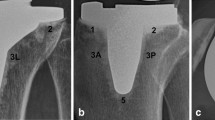Abstract
Early non-progressive horizontal radiolucent lines (RLLs) (<2 mm) under the tibial component following cemented total knee replacement (TKR) are considered to result from poor cement injection into cancellous bone. These RLLs may facilitate the entry of joint fluid and wear debris into the interface, which may proceed to ballooning osteolysis. There is currently no consensus on the preferred cementing technique (single- versus two-stage cementation) in TKR. We have prospectively analysed postoperative radiographs in 50 consecutive TKRs to compare the RLLs following single- (25 TKRs) and two-stage (25 TKRs) cementation techniques. Of the TKR radiographs studied, 26 (52%) had RLLs; nine (36%) of these were single-stage TKRs, and 17 (68%) were two-stage TKRs. This study demonstrates that single-stage cementing may be superior to the two-stage technique in terms of avoiding RLLs in immediate postoperative TKRs.
Résumé
Après prothèse du genou, un liseré (RLLs) (<2 mm) apparaît de façon très fréquente, précoce, et non évolutive, sous le plateau tibial. Celui-ci est probablement secondaire à une mauvaise pénétration du ciment à l’intérieur du tissu spongieux. Ces liserés facilitent la pénétration du liquide articulaire et des débris d’usure au niveau de l’interface et peuvent être responsables d’ostéolyses. Il n’y a pas de consensus actuellement sur la technique de cimentage (cimentation en un temps ou en deux temps). Nous avons analysé de façon prospective les radiographies de 50 prothèses totales du genou consécutives en comparant les liserés (RLLs) après cimentage en un temps ou en deux temps. 26 (52%) des prothèses totales du genou avaient un liseré, 9/25 (36%) présentaient un liseré inférieur à 2 mm dans les cimentages en un temps, 17/25 (68%) un liseré dans les cimentages en deux temps. Cette étude montre de façon claire que le cimentage en un temps est supérieur à la technique du cimentage en deux temps et évite les liserés immédiats post-opératoires.



Similar content being viewed by others
References
Ahlberg A, Linden B (1977) The radiolucent zone in arthroplasty of the knee. Acta Orthop Scand 48:687–690
Bach CM, Biedermann R, Goebel G, Mayer E, Rachbauer F (2005) Reproducible assessment of radiolucent lines in total knee arthroplasty. Clin Orthop 434:183–188
DiMaio FR (2002) The science of bone cement: A historical review. Orthopaedics 25:1399–1407
Dorr LD, Conady JP, Schreiber R, Mehner DK, Hudd D (1985) Technical factors that influence mechanical loosening of the total knee arthroplasty. In: The Knee: 1st Sci Meet Knee Soc. Baltimore University Press, Baltimore, pp 121–135
Ecker ML, Lotke PA, Windsor RE, Cella JP (1987) Long term results after total condylar knee arthroplasty. Significance of radiolucent lines. Clin Orthop 216:151–158
Ewald FC (1989) The knee society total knee arthroplasty roentgenographic evaluation and scoring system. Clin Orthop 248:9–12
Krause WR, Krug W, Eng B, Miller J (1982) Strength of the cement-bone interface. Clin Orthop 163:290–299
Reckling FW, Asher MA, Dillon WL (1977) A longitudinal study of the radiolucent line at the bone–cement interface following total joint -replacement procedures. J Bone Joint Surg 59A:355–358
Ritter MA, Herbst SA, Keating EM, Faris PM (1994) Radiolucency at the bone–cement interface in TKR. J Bone Joint Surg Am 76:60–65
Schneider R, Hood RW, Ranawat CS (1982) Radiologic evaluation of knee arthroplasty. Orthop Clin North Am 13:225–244
Sherman RMP, Byrick RJ, Kay JC, Sullivan TR, Waddell JP (1983) The role of lavage in preventing hemodynamic and blood-gas changes during cemented arthroplasty. J Bone Joint Surg Am 65:500–506
Smith S, Naima N, Freeman MAR (1999) The natural history of Tibial radiolucent lines in a proximally cemented stemmed total knee arthroplasty. J Arthroplasty 14:3–8
Stannage K, Shakespeare D, Bulsara M (2000) Suction technique to improve cement penetration under the tibial component in total knee arthroplasty. Knee 10:63–73
Walker PS, Soudry M, Ewald FC et al (1984) Control of cement penetration in Total Knee Arthroplasty. Clin Orthop 185:155–164
Author information
Authors and Affiliations
Corresponding author
Rights and permissions
About this article
Cite this article
Guha, A.R., Debnath, U.K. & Graham, N.M. Radiolucent lines below the tibial component of a total knee replacement (TKR) – a comparison between single-and two-stage cementation techniques. International Orthopaedics (SICO 32, 453–457 (2008). https://doi.org/10.1007/s00264-007-0345-6
Received:
Accepted:
Published:
Issue Date:
DOI: https://doi.org/10.1007/s00264-007-0345-6




